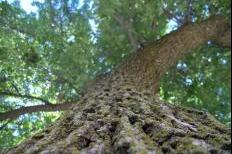







An invasive beetle, which may be present in Dane County, could destroy almost a quarter of the trees that border city streets, according to city and state experts, but residents can slow down its spread by not transporting firewood.
After discovering a number of adult emerald ash borers in Mirror State Park, the Wisconsin Department of Agriculture, Trade and Consumer Protection (DATCP) placed Sauk County under temporary quarantine for the beetle on July 15, pending federal approval, according to a statement. The quarantine prohibits wood products, such as firewood, from being moved out of the county to other areas of the state that do not have an infestation.
The emerald ash borer, native to China, entered the United States about 10 years ago through packing material. Since appearing in Michigan, the beetles spread rapidly, appearing in Wisconsin in 2008. Eighteen other Wisconsin counties have been placed under quarantine, according to the DATCP statement.
The DATCP quarantined Jefferson County earlier this year and Rock County last year. While a May study of Madison’s ash trees did not detect an emerald ash borer infestation, Rock, Jefferson and Sauk border Dane County.
“It could be here, but not yet detected,” Laura Whitmore, Madison Parks spokeswoman, wrote in an email to Madison Commons. She noted that with an unknown number of ash trees in parks and thousands on private property, the beetles “could have a devastating effect on our urban forest.”
DATCP spokeswoman Donna Gilson said cities and villages throughout Wisconsin planted ash trees after Dutch elm disease killed thousands of elm trees in the 1950s, ‘60s and ‘70s.
“In many of our cities and villages, there would be probably entire blocks that would be pretty well decimated,” Gilson said.
Gilson said people can slow down the spread of the emerald ash borer by not transporting firewood. She said the emerald ash borer spread about one to two miles every year since that is how far the beetles can fly, unless humans carry it with them.
Gilson recommended that campers buy firewood close to their campsites and refrain from bringing it back home with them.
“Burn it where you buy it and if you don’t use it all up, be kind and leave it for the next camper,” Gilson said. “It’s not worth it. You don’t want to be the one who brings emerald ash borer to the city of Madison.”
The city has been working since 2008 on how to mitigate the impact of the beetles. The City of Madison created a task force to address the issue and changed its tree replacement practices, selecting from 29 instead of 16 different tree species and plants to minimize future impacts of invasive species, according to Whitmore.
She noted that the city’s efforts to preemptively remove and replace old ash trees with new trees, as well as efforts by property owners, could play a role in limiting the impact of the emerald ash borer.
“The best thing a homeowner can do is to educate themselves on the trees in their yard and neighborhood, learn about the symptoms, and report any possible sightings,” Whitmore wrote.
The DATCP recommends that people keep a close look on ash trees for signs of possible emerald ash borer infestations. These include a thinning canopy, cracked bark – possibly with D-shaped holes – and new branches sprouting low on the trunk. Another sign is woodpeckers pulling at the bark of the tree to get to insect larva beneath it.
Once an infestation occurs, trees will likely last two to four years before the insects kill them, Gilson said. She noted, however, that if an infestation is discovered early and the tree is small, landowners have had luck in extending the life of the trees and fighting off the beetles.
Landowners living near an infestation should pursue preventative treatments, she said.
“Once you’re within 15 miles of an infestation, just consider it that if you’re not infested now, you will be,” Gilson said.
Landowners should consult professional arborists about the tree, according to Gilson. They can also use insecticides such as imidacloprid to prevent infestations, but should consider the expenses behind the pesticide treatment since they need to be used every year.
People who think they have emerald ash borers on their property should contact the City of Madison by phone or by email at EAB@cityofmadison.com and attach a photo.
For more information on the emerald ash borer, go to http://www.cityofmadison.com/parks/services/forestry/pests/EAB/.
To read the city commission’s plan to address the borer, go to http://www.cityofmadison.com/parks/services/forestry/pests/EAB/documents/2012SeptemberEABPlan.pdf.
|
|
|
Welcome to the Madison Commons, a website designed to provide news and information about all of Madison's neighborhoods and a crossroads for the discussion of community issues. The name comes from the idea of a village commons, a place for news, talk, debate, and some entertainment, too, that's open to everyone.
All rights reserved. Read more about the Madison Commons and its partners.

